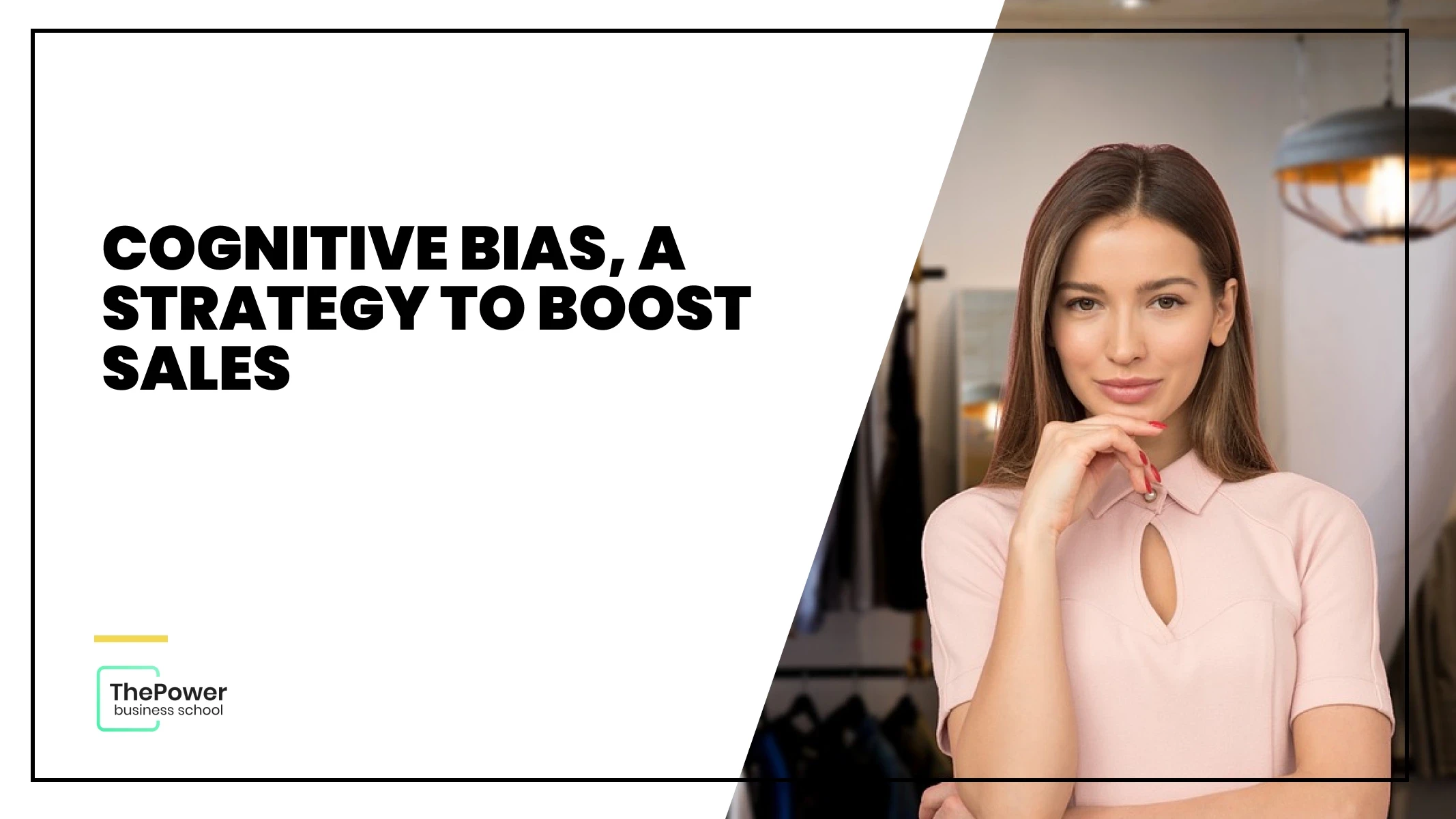How to Boost Your B2B Copywriting: Full Guide

Franco Brutti
In this guide, I’m going to teach you how to write high-converting B2B (business-to-business) copy: The step-by-step advice covers all the key areas of B2B copywriting, including:
Content strategy
Attention-grabbing headlines
High-conversion emails
PPC ads
And much, much more...
After reading you’ll be able to write better copy, faster, and for a wider range of audiences.
So if that sounds good to you, let’s get started.
What Is B2B Copywriting?
First and foremost, it would probably help if we went ahead and defined what exactly B2B copywriting is.
Now, there are probably as many definitions of “B2B Copywriting” as there are B2B copywriters themselves. However, I’ve generally found this to be the best way to define B2B copywriting:
“B2B Copywriting is the use of written language to persuade customers to purchase a product or service by highlighting how it fulfills a specific need.”
Why do I like this definition so much?
Because almost all B2B copywriting is dedicated to persuading customers to take a specific action. This could be to sign-up for a newsletter, attend a live webinar, view a product demonstration, or even directly purchase the product.
As B2B copywriters, we attempt this through the effective use of language, communicating the product’s strengths and ultimately, how it fulfills a customer’s needs.
What is the difference between B2C and B2B copywriting?
Another question I’m often asked is how does B2B copywriting differ from B2C (business-to-consumer) copywriting?
A good question, as it appears when writing to a B2B audience copywriters frequently feel overwhelmed. It’s as if every word will be read by the entire targeted corporation.
However, that of course is not the case!
Although the company you might be targeting is a large B2B organization, it will always be a real person reading your copy - just as in B2C.
The typical difference between B2B and B2C is the type of benefits the copywriter focuses on.
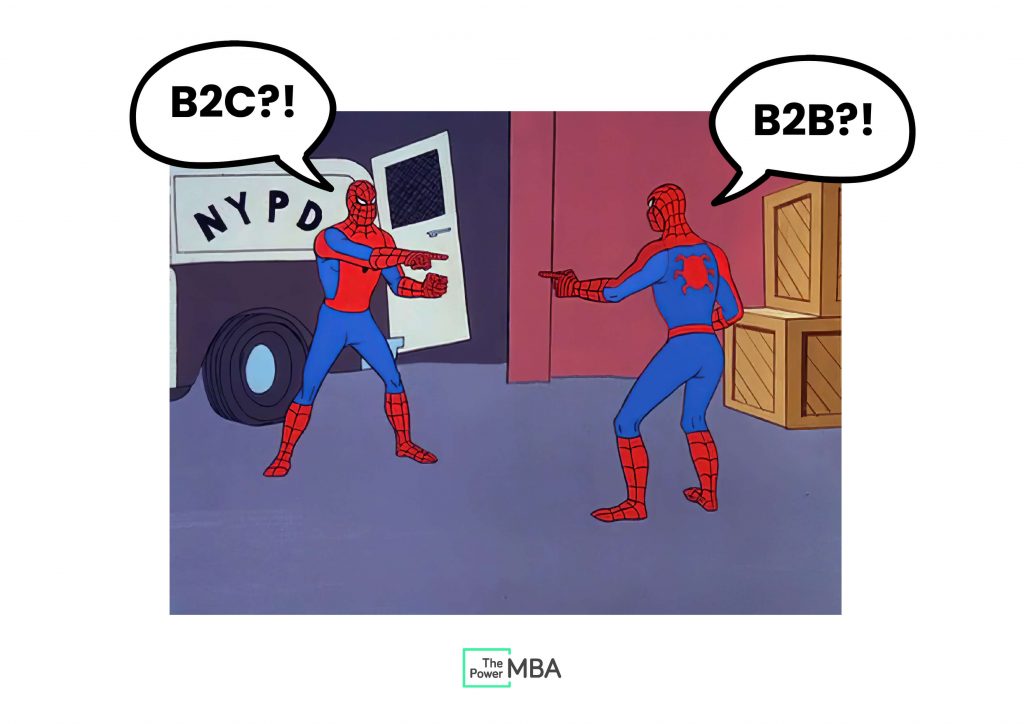
B2B ‘Hard’ Benefits
In B2B, these tend to be ‘hard’ benefits. Something concrete your product or service offers your target audience such as increasing revenue, cutting costs, improving efficiency, etc.
They are tangible improvements that can be easily measured (think a percentage increase or reduction in hours).
For example, a copywriter working for a mobile CRM SaaS provider is going to focus on the software’s tangible benefits. They’ll be looking to persuade sales directors to purchase the software by highlighting:
How much time their field reps could save on admin work
How the average revenue of each field rep would increase
How the number of clients visited per field rep would increase
B2C ‘Soft’ Benefits
In B2C, it tends to be a little different as copywriters focus on ‘soft’ benefits. These are things that can’t be measured quantitatively, such as convenience, fun, or positive emotions.
For example, when buying a new pair of shoes you wouldn’t normally conduct a cost-benefit analysis, right? You’d be thinking more about how you look and feel in them. Are they stylish? What outfits would they look good with?
Not about the durability of their rubber soles…
As you can see, style and emotion are difficult to measure. There’s no tangible way to plot them on a graph so to speak - which is why we normally associate this form of copywriting with B2C.
However, even if you’re selling to a business, the purchase decision will still be made by a person (or group of people).
And guess what...they feel emotions, too.
This is why getting to know your buyer persona is key. Not only does it give you a greater insight into their needs, but also the emotions they’re feeling and how to appeal to them.
Buyer Persona
Everything in marketing (and by extension, copywriting) starts and finishes with the customer.
Without them, a business simply wouldn’t exist.
This is why before any content strategy is thought up and definitely before fingers start typing away at a keyboard, that the copywriter (well, the entire marketing team really) is aware of the company’s various buyer persona(s).
For those new to the term, a buyer persona is:
“A fictional representation of a typical target customer”
By actively taking the time to understand your customer, as a copywriter, you’ll be able to tailor your wording to speak directly to them and effectively address their needs.
How to Create a Buyer Persona
If this is your first time, we've put together a detailed guide on how to create a buyer persona buyer unique to your business
But for now, here's a quick overview.
Basing your buyer personas on real data as opposed to “gut instinct” is always preferred. This includes gathering basic customer information such as:
Age
Gender
Geography
Hobbies
Interests
Language
This can all be pulled from market research, your CRM, Google Analytics, LinkedIn Navigator, and other social media analysis tools.
Once that’s completed, you’ll want to start digging a little deeper. You need to identify:
Major customer pain points
Their individual goals
How your product meets their need
This is always best done in conjunction with the sales team and customer service. They’re the ones interacting with your customers (and potential customers) daily and from my experience, nobody has a greater understanding than they do.
So, get them in a room together with your marketing team and start to chew the fat.
Ask yourselves:
What problems are they attempting to solve?
What’s stopping them from achieving their goals?
How would you describe their ‘endgame’?
What does success look like to them?
How does your product solve their problems?
What are your customers’ primary barriers to purchasing?
Now, gather your research together and start looking for common themes amongst the answers.
Is there a particular demographic your product appeals to? Is it more popular in certain regions/countries than others? Have there been 2-3 common pain points shared across the majority of your customer base?
As you go through these answers you’ll start to build certain buyer personas from the collated data.
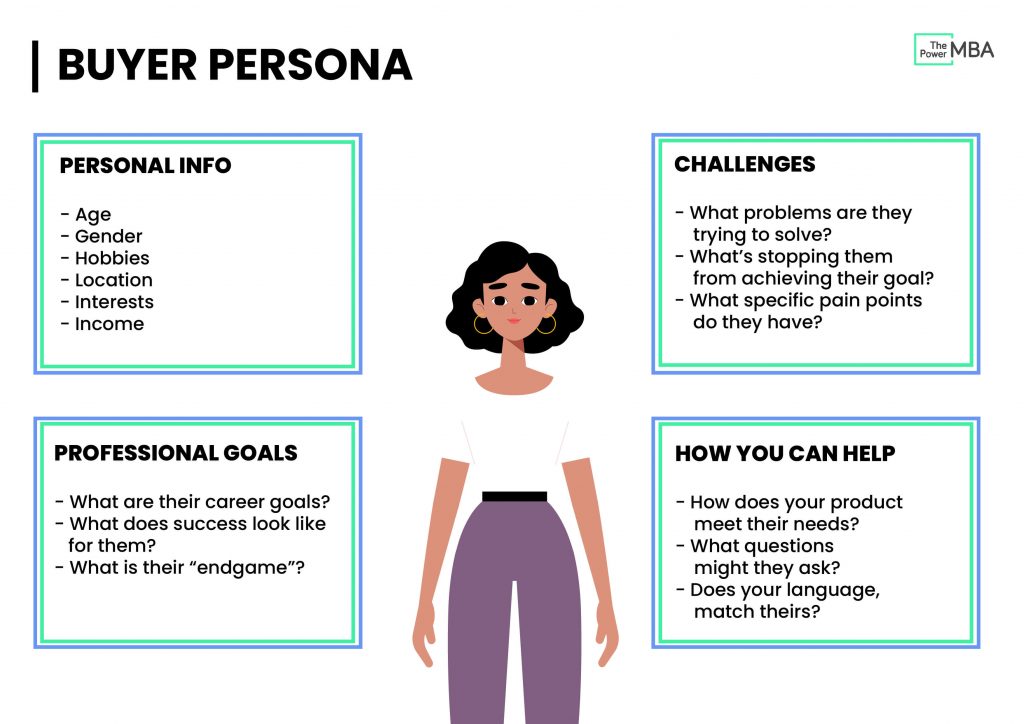
These are the fictional characters you will be writing to.
Personally, it helps to give them a name. This way, when you’re writing it feels more authentic - like you’re writing directly to another person.
Remember, even when working in B2B, you’re always addressing a person - not the entire conglomerate business.
B2B Content Strategy
Right, so I have to admit I did hum and haw a bit over whether or not to include this section within the guide. I’m keenly aware that this is a B2B copywriting guide, NOT content strategy - something I created a separate guide for.
However, it just didn’t feel right continuing without at least going over some of the basic concepts first - those I see omitted from the majority of B2B strategy plans.
I find it massively helps guide my copy if I understand why I’m writing what I’m writing when put in context with the organization’s wider goals.
Hmm...goals
Sounds like a good place to start!
Content and the company’s goals
The first place to start with almost any content strategy plan is goals. You need to think about:
“What are the business’s short-term and long-term goals over the next 3-6-12 month period?”
Once you’ve jotted down 2-3 ideas, you now need to figure out how content can help achieve those goals.
For example, an organization’s wider goal might be to become (or at least perceived as) the #1 authority on a certain subject. Essentially, every time a customer thinks about something related to your company’s industry, they think of you.
Can you think of any content actions that might help achieve this goal?
What about:
Building brand awareness
Long-form “expertise” content
Content collaborations with partners and industry influencers
This makes sure each piece of content has meaning and is aligned with the overarching objectives of the company (not something that’s going to gather dust on p.24 of your blog).
Also, remember that the objective has to be measurable...I can’t stress enough how important that is.
What can’t be measured, can’t be managed (or more importantly, improved)!
Focus on your “Sweet Spot”
I hate to break it to you, but you can’t be an expert at everything. Despite what you might think of yourself (and your brand) there are people out there better at certain things, than you.
A sad fact of life I’m afraid.
So, instead of fighting that fact just let it go. Let others write about their areas of expertise while you focus on your “sweet spot”.
As the founder of the content marketing institute Joe Pulizzi puts it:
“The sweet spot is where your particular fields of knowledge and your skill sets intersect with a passion point — something you feel is of great value to you personally, or to society at large.”
For B2B companies this about discovering where your expertise intersects a customer’s needs.
These are the topics you want to own. The areas that you understand and can talk about better than anyone else.
This holds true for every company, whether you’re selling ice cream cones or a multi-purpose cloud marketing solution.
In our case at ThePowerMBA, we focus on digital marketing and entrepreneurship. We feel these areas of expertise intersect both our passions and customer/student’s needs.
Unfortunately, that means I rarely find an opportunity to talk about ice cream…
But hey ho, I’ll let Ben and Jerry do that.
Content Funnel
Now that you’ve outlined the company’s goals and uncovered your content sweet spot, you can start to build out a content funnel.
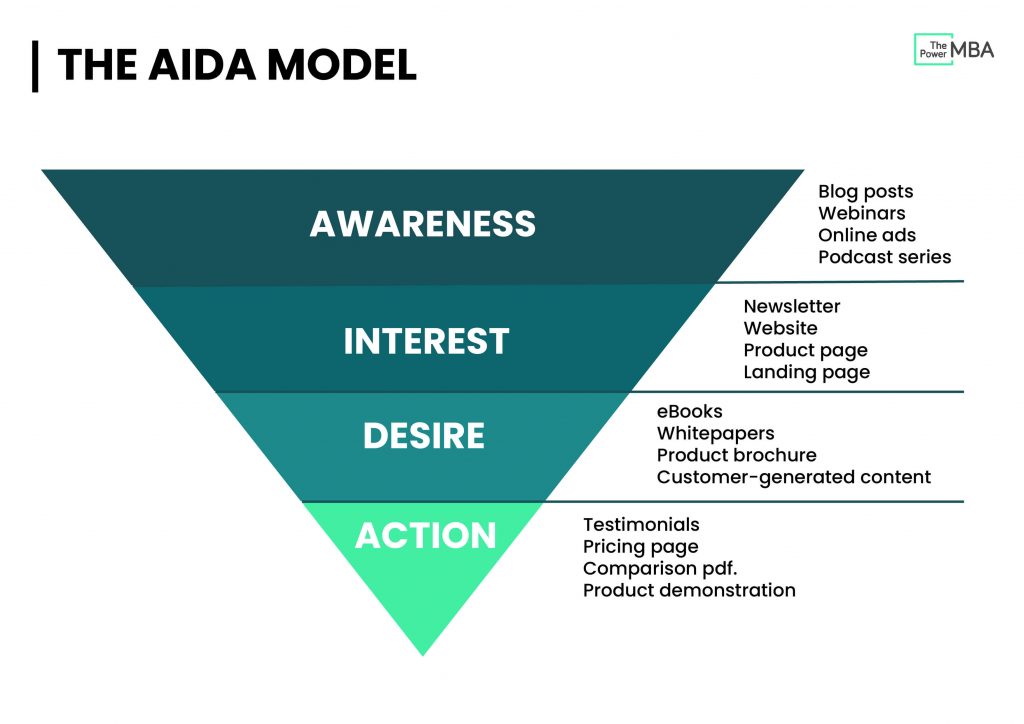
A content funnel is essentially the path a stranger takes from the first moment they engage with your brand content, to purchasing your product.
The path winds through four separate stages commonly referred to as AIDA:
Awareness
Interest
Desire
Action
As you can see from the chart above, the type of content changes as readers progress down the funnel. It becomes more direct and salesy.
The more engaged a reader is, the more perceptive they’ll be to this style of content. If they decide the content (or perhaps product) isn’t really for them, they simply drop out of the funnel.
For B2B copywriters, this information is like gold dust.
Knowing where customers are in the funnel - ideally through a targeted lead nurturing campaign - helps you adjust the aggressiveness of your copy.
If a reader has spent considerable time viewing content from the Desire stage, it’s likely your product resonates strongly with them.
As I mentioned at the beginning of the section, this is just a brief overview of a topic that deserves considerably more attention than I could ever give it here.
Anyway, the goal here was simply for you to understand the larger context or framework you’ll be writing under.
Hopefully, that’s become clear now.
So without further ado, let’s move onto the nitty-gritty of B2B copywriting
Types of B2B Content
Headlines
As a B2B copywriter your headline is likely the first, and perhaps only chance to make a good impression with readers.
Grab their attention, and they’re yours (for the next 2-3 minutes or so at least) - lose it and well, you might as well not have bothered with the rest of the copy.
That’s how important a good headline is.
Also, they crop up in almost all formats of B2B copywriting:
Newsletters
Banner ads
Landing pages
Website copy
Therefore, learning how to create engaging, eyeball-grabbing titles should be at the very top of your to-do list.
How to write a great headline
Before a pen hits the proverbial paper, copywriters need to understand what it is that causes readers to click. What is their thought process?
It turns out that in 99% of cases readers make the same cost-benefit calculation before clicking:
“Will clicking this headline (the content’s value) be higher than what it costs me (a few seconds or minutes of my time)?”
The #1 role of every single headline, ever written, is to highlight the benefit a reader gains from engaging with the content, and why it outweighs the time taken to do so.
The more specific you can be with the benefit, the better.
A great exercise I find is to put yourself in the reader’s shoes and ask yourself this question:
“How is this content going to benefit me?”
If the answer isn’t glaringly obvious then the title needs an immediate re-work. Look at the title of this post, for example.
B2B Copywriting Guide: Turning You Into the Next Hemingway...Well, Almost
My promise to you is a B2B copywriting guide that will potentially, almost, maybe turn you into the next Hemingway...
Alright, there might be an air of sarcasm in this promise but the benefit is clear.
This is why understanding your buyer persona is key. Looking at your copy from their perspective enables you to empathize with their position.
The most important trait of successful marketing, right?
The “How-To” Header
This is arguably the most important weapon in your headline arsenal.
Everybody, and I mean everybody, has at some point been drawn into an article because of its irresistible “how-to” header.
How to Find a Job and Make $1m (all without lifting a finger)
How to Save Time and be More Productive
How to Write B2B Copy That Readers Just Can’t Put Down
I mean, there’s just no way you’re scrolling through your feed and not clicking on these titles…
The power of the “how-to” title comes to life when the two stated benefits are related, like finding a job and becoming a millionaire, or saving time and being more productive, etc.
This then has to be backed up by some high-quality content that then delivers on this promise.
In fact, this format of headline can also work if we remove the “to”.
How I Became A Millionaire With Nothing but a Spade
How I Got 5x Faster In Under 6 Weeks
How I Worked 10-hour Weeks And Became More Productive
A promise is still being made to the reader, with a clearly outlined benefit, but the nature of the title’s structure adds an element of intrigue.
I mean, how does someone become a millionaire with nothing but a spade? Curious, right?
This intrigue could be the difference between someone browsing over your article and clicking in on it.
List Post Headlines
Another staple diet to the B2B copywriter’s arsenal is the List Post.
Yes, it is often (and perhaps, fairly) accused of being behind every piece of clickbait ever created.
But that’s not the title's fault!
Clickbait is the creation of sub-standard content by the copywriter...the title is simply doing its job by pulling in more readers.
So why do list titles that set a number of tips, secrets, or techniques always work?
Because you’re making a very clear, specific promise to readers about what to expect from the article; a nice, quantifiable return on their investment.
Let’s look at some examples:
5 Leadership Qualities Every Regional Manager Should Possess
7 Reasons Why (X) Software Will Increase Your Business Revenue
4 Tried and Tested Strategies For Boosting Your Sales Team’s Performance
12 Best-Kept Secrets to Becoming a Better Lover
They might seem crude, but they'll certainly increase the CTR (click-through-rate) of your content.
If you’re wanting to dive deeper into headline copy, then I highly recommend investing time in a wonderful resource from the team at Copyblogger.
Their eBook How to Write Magnetic Headlines has helped me no end in putting together winning headlines.
PPC Ads and Landing Pages
PPC (pay-per-click) online advertising platforms such as Google Ads, Facebook Ads, and LinkedIn Ads are the backbone of most B2B marketing campaigns.
They allow companies to get hyper-specific with their audience targeting (think certain keywords, demographics, regions, age-groups, gender, etc.) - something traditional media has never offered.
Also, since the platforms run PPC, advertisers only pay when a visitor clicks on one of their ads.
A dream scenario, right?
Well, while PPC certainly has huge upside it’s going to put a lot of pressure on you - the B2B copywriter.
Because while the goal of any online ad is to win over eyeballs and mouse clicks, if they don't convert into hard sales, they get very expensive, very quickly.
Looking for an easy scapegoat, marketers quickly point the finger at your copy as the underlying reason for their failure…
So what can you do to remedy this?
As readers are required to make a follow-up action after they’ve engaged with the ad, where you send them is extremely important.
For example, if your copy promises readers a software solution that solves a specific problem they have, direct them to a landing page that focuses on THAT problem alone.
Don’t just send them to your home page, as this is where people will drop off.
They’ve clicked on that ad because that problem resonated with them. They’re expecting to hear exactly what you’re going to do about it - not the latest news outlets you appeared in.
Try thinking of the two like that glorious couple from Alice in Wonderland...
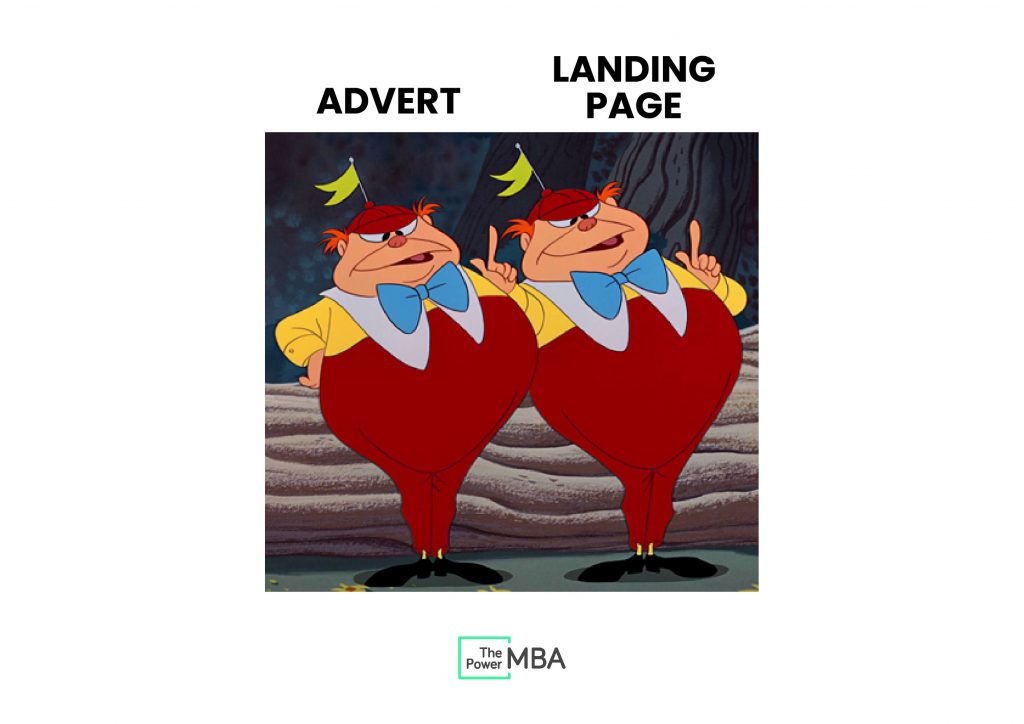
Inseparable!
How to write copy for B2B Ads
PPC ads are generally very, very short in length. That means copywriters have to be extremely precise in their copy and clear of the overall goals of the campaign.
Let’s take a look at Google Ads:
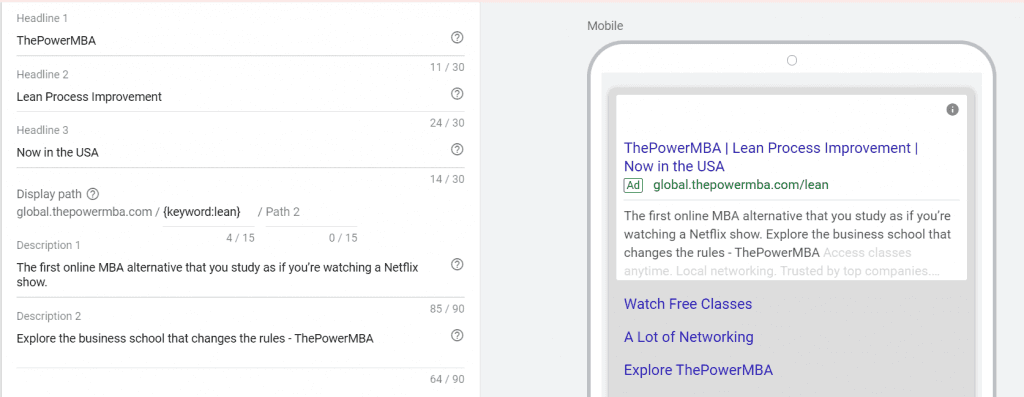
As you can see on the right-hand side of each copy bar, there’s a strict limit.
With only 30 or so characters available for your headers you’re going to find you get good at trimming the fat from your copy.
I find starting in the following 3-4 areas to be typically helpful:
Overly long adjectives
While “breakneck”, “electric”, and “supersonic” sound great when boasting about the speed of your software solution - they’re also going to eat into your character limit.
Shorter words such as “rapid,” “swift,” and “agile” do the same job, at a fraction of the character cost.
Superlatives and Hyperbole
these are all the fancy words we all chuck into our copy when describing our product as the absolute, #1, dogs ******** of the industry. Words such as “premier,” “unparalleled,” and “most-trusted” come to mind.
While they sound impressive when transitioning from our brains to paper, all they end up doing is setting off our reader’s BS detectors. If the product is, as good as you say, you wouldn’t need to make that claim now, would you?
Too many exclamation marks
If you feel the urge to add them to your copy, keep it to just the one…
Adding two, three (and yes, I’ve even seen four) does nothing to make your copy stand out further. It actually has the opposite effect, making readers feel like you’re barking at them.
With that said, let’s take a look at a quick example.
B2B Ad and Landing Page Example: Albacross

After browsing through the headers of this ad from what I assume is a B2B lead generation company, what are your thoughts? Do you think the copy is effective? Is the promise clear to readers?
I think so.
First of all, there’s no jargon, hyperbole, or excessive punctuation. Instead, the copy is punchy and straight to the point, with a clearly defined promise:
“If you click on me, I will take you to a place that helps you get more qualified B2B leads”
The description below the headline is also catchy and BS-free. It gives readers an insight into how this company increases your B2B leads, while also highlighting the benefit:
“...increase your sales today”.
Overall, I’d say the ad copy is solid.
Though of course, as any ad campaign manager will tell you, that all depends on what the data says.
Another strength of digital advertising is its measurability.
You can A/B test any number of variables, from the time the ads are displayed to accompanying graphics (if a display ad) and of course, the copy and headlines.
If the ad’s effective, the data from the campaign analysis will point that out.
Right, back to our example…
Remember what I said earlier about Tweedle Dee and Tweedle Dum?
Well, we’ve looked at Dee, so it's time to turn our attention to Dum:

This is the landing page you arrive at after clicking the ad. Again, let's quickly analyze what we’ve got here.
We can see the page URL is:
www.albacross.com/b2b-lead-generation, not www.alabacross.com
Good, they’ve not directed us to a generic home page, but one clearly dedicated to B2B lead generation - as promised in the ad.
The header is also bold, and straight to the point. The promise of more qualified B2B leads will be fulfilled in exchange for a work email address (notice how the word ‘work’ neutralizes any fears readers have about their personal address being spammed).
For me the CTA is a little aggressive, asking for a demo right away. It’s still unclear exactly what it is we are demoing.
However, if you do scroll down the page there’s additional information about the product:
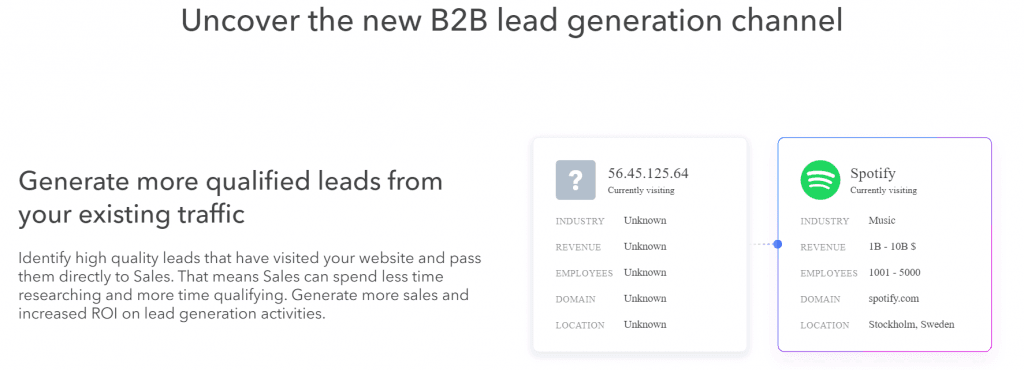
As well as social proof:
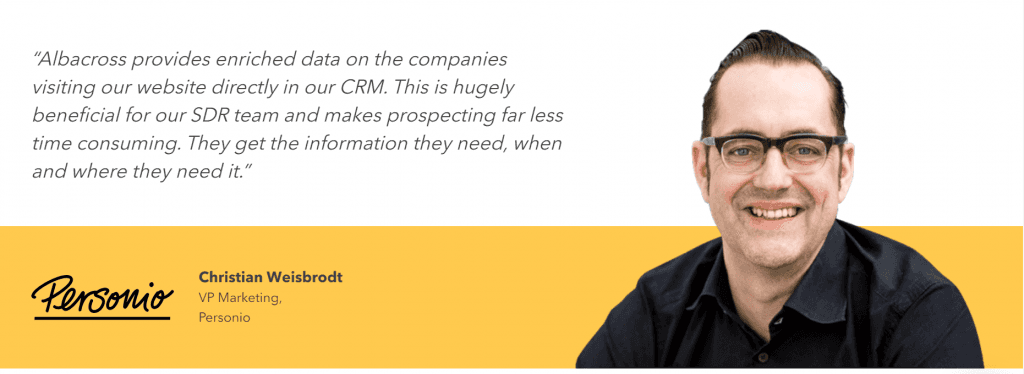
The main thing is that the landing page has a clear, measurable goal related to its accompanying ad copy.
This will reduce the number of people “dropping off” and increase the success of the overall campaign.
One final thing I want to reiterate before moving on is just how important it is to understand your buyer persona.
Try asking yourself:
Why have they typed in this keyword?
What problems are they attempting to resolve?
How can you position your product to solve them?
If you can figure out what their expectations are when typing in certain keywords (Google Ads) and what they’re hoping to find, it will really help guide your copy.
B2B Website Home Page
As a B2B copywriter, you’re probably responsible for the creation of all website content - not just the home page.
However, running through the nuances of each page would likely require a dedicated guide of its own.
So, I’ve decided to focus on the home page. After all, it’s going to be where 90% of your backlinks head to. It’s also your first (and perhaps only) chance to make a good first impression with visitors.
Therefore, within seconds of landing on the page, they need to have a clear idea of:
Who you are
What you do
Why they should read on.
If not, they’ll leave.
Writing copy for your B2B Home Page
Many B2B copywriters try “attracting” visitors by throwing big, sexy, complicated words at them…
You’ve probably seen it yourself - like the following header:
The industry-leading, ground-breaking, 360-degree cloud marketing hybrid solution - empower your business, today…”
How silly does that sound?
When looking to convert browsers into buyers, people not only need to understand what it is you're selling but have some confidence in your ability to deliver as promised.
A little hard to do if they believe you're an idiot, right?
This is why I find the complete opposite to be more effective.
Using short, simple wording is more impactful. Think of the everyday language you use with friends and family.
You sound relatable, trustworthy, and credible - like you’re talking to the reader, and not at them.
Also, try avoiding an insincere tone of voice when addressing readers.
“We at (X) organization are dedicated to delivering the best in-house…” or “We are proud of our achievements and philanthropic work…”
It sounds so pompous and disingenuous it turns readers off immediately.
You can picture the CEO of (X) organization sitting there, behind their desk smiling wryly at you, counting the pennies as they drop out your pocket and into the company books.
So don’t be that company.
B2B Web Page Copy Example: Hootsuite
With that said, there are a lot of people doing home page copy well. Take Hootsuite, for example:
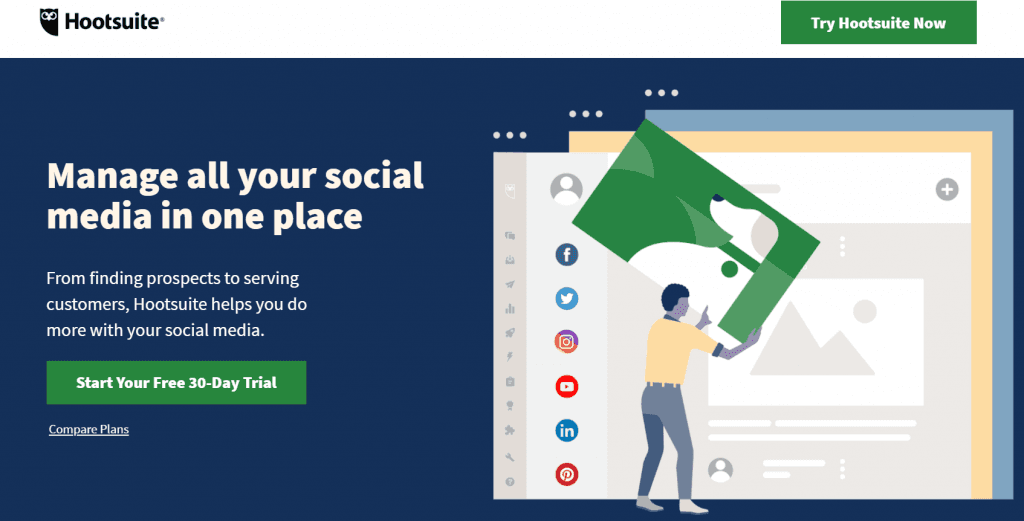
What do you make of their H1 and description?
“Manage all your social media in one place - From finding prospects to serving customers, Hootsuite helps you do more with your social media”
It’s pretty clear what they offer, right? A centralized tool from which you can manage your different social platforms.
The language is also clear and straight to the point.
If you are interested in this product, their above-the-fold content is intriguing enough for you to continue reading.
So, let’s scroll down a little and see what else we find:

Once readers are aware of what the company offers and its UVP (unique value proposition) typically you want to highlight which problems you solve.
As you can see, Hootsuite gets straight to it. Notice the clarity of their copy.
“Plan, Create, Schedule”
Three clear areas the product helps customers with.
So, after a single mouse scroll, we now know:
What they do
The problems they solve
The benefits they offer
If we are still interested, we’re likely looking for social proof. We want confirmation that others have tried it first.
Let’s see if they’ve cottoned on to that...
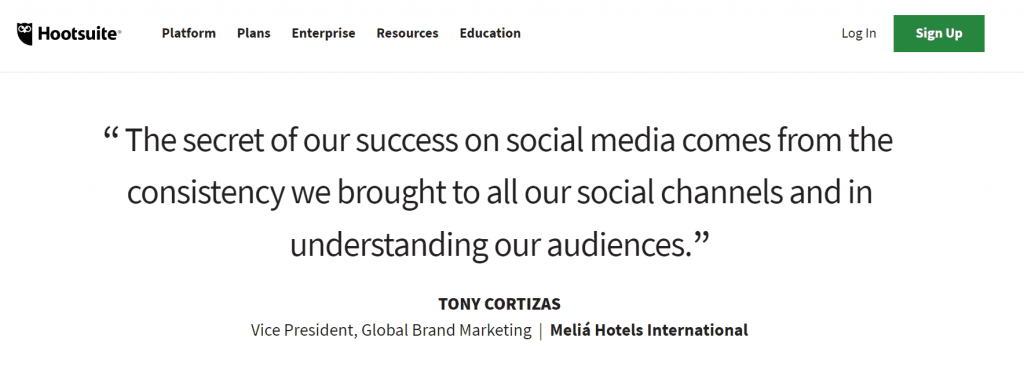
Yup!
A couple more scrolls down the page and we have confirmation from Señor Cortizas.
Alternatively, you could include statistics, testimonials and other B2B case studies on your home page. This provides further evidence your product does exactly what it says on the tin.
B2B Web Page Copy Example: Ahrefs
Another example I want to show you is Ahrefs.
Not only is it a fantastic product, but their copy is also on point. Take a look below:
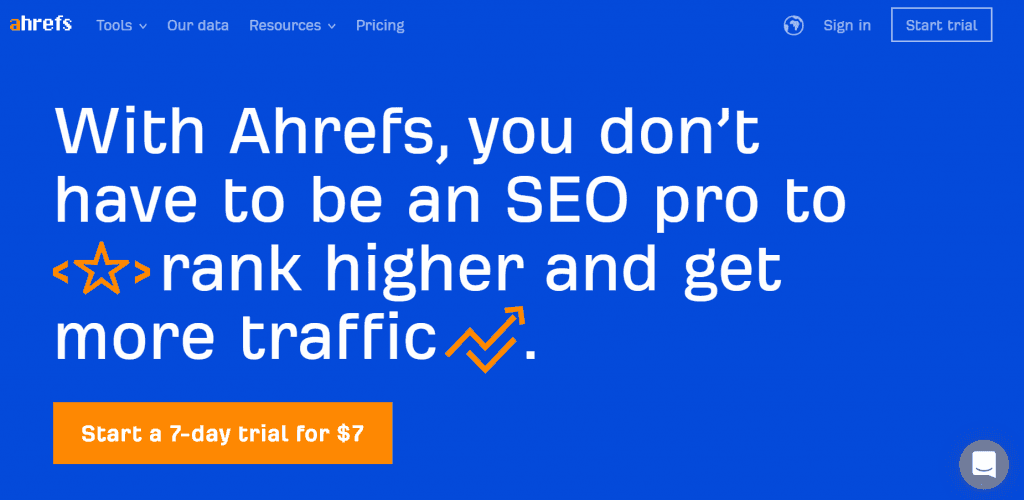
What do you think of this H1?
It’s intriguing, right?
“With Ahrefs, you don’t have to be an SEO pro to rank higher and get more traffic”
I don’t have to be an SEO pro to rank higher in Google? Really? Wow...what’s this all about then?
Tell me more!
While they don’t say exactly what the product is, they do focus on two distinct benefits:
Not having to be an SEO pro to rank
Getting more traffic
They withhold the key information as to how they do this, creating a sense of intrigue. It makes us want to continue reading.
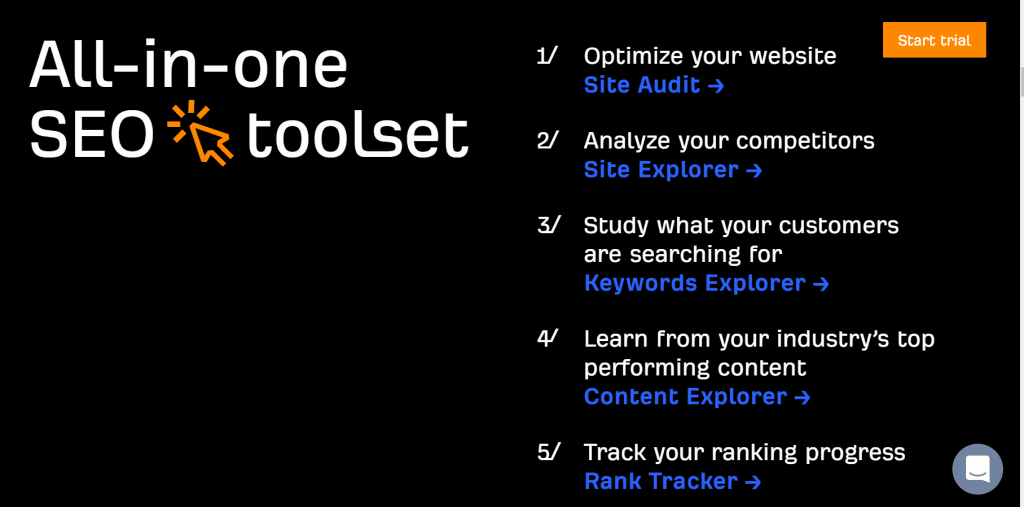
Ahhh, so this is how they do it. By offering an:
“All-in-one SEO toolset”
All has been revealed.
What I like about this section of the home page is its simplicity. The copy is laid out in 5, easy-to-read bullets that detail the product’s functions.
There’s no fluff, no hyperbole, and no ambiguity.
Now I’m looking to know more. Are your customers happy with the product?
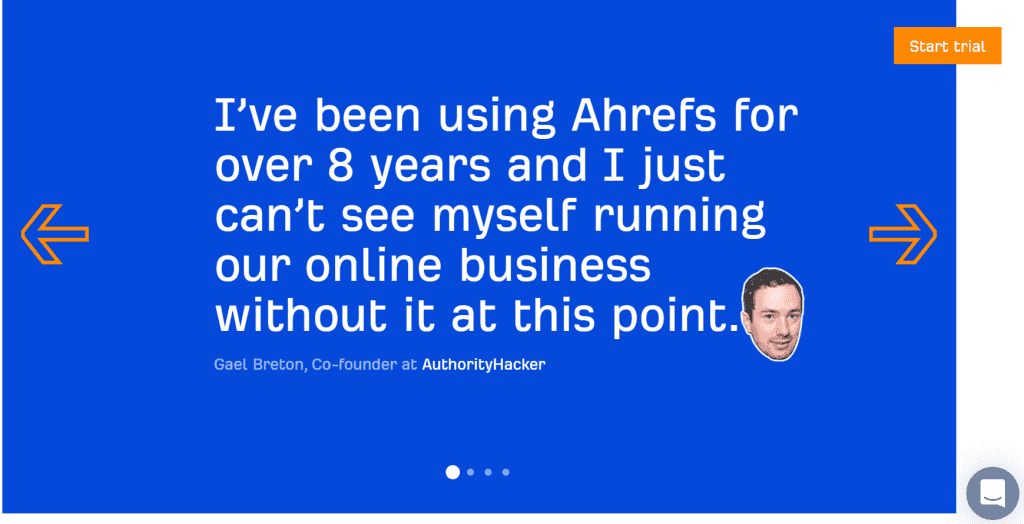
It appears so!
Another thing, did you notice the small, orange CTA (call-to-action) that’s been following us this whole time?
The goal of a B2B home page to inform visitors about what you do - but also, you want them to take action.
Not everyone will be ready to buy your product or service on the spot, so you might want to A/B test different copy, colors, and types of CTA.
Again, this will maximize the conversion rate of your page.
Emails
To round things up, let’s take a look at B2B emails.
Now, like most of the topics covered in this post, there isn’t enough time or space to delve too deep into email marketing.
It is a beast of its own...
Optimizing CTRs, templates, open rates, bounce rates, spam scoring, sharing, and overall ROI (return on investment).
The list does go on, but not here. Here I will be focusing on email copywriting.
Now the difference between writing emails to colleagues and customers (or potential customers) is the end goal.
B2B email copy looks to sell.
This could be converting leads, increasing readership, and hard-selling products. Essentially, we’re looking for readers to take action in a way that benefits the business.
How to Structure and Write a B2B Email
The first place to start is going to be the subject line.
Much like the headline of a B2B blog post, ad copy, or landing page, the subject is your split-second chance to grab a reader's attention.
Think about your personal (and work) inbox. How many emails do you get daily? Maybe 30, 40, 50? 100?
And how many of them do you open?
It’s far easier to discard an email than it is to read it. That cost-benefit analysis we talked about earlier...
This is why you must give readers a reason to open.
What is that one unique factor that sets your product apart from competitors? What is the primary benefit readers gain from reading this email?
Grab the answer, shorten it, and pop it in your subject line.
You’ll also want to keep it short - at around 30-40 characters. Any longer and readers simply won’t see it.
The team at Coconut did a good job with a recent email:

You’ll see how they start the subject line with the key benefit - “claim your investor reward”. It’s also brief, and to the point, just squeezing in Hotmail’s character cap.
Another thing I’d like to point out is the From subject.
In this case, the email was sent from Sam, the CEO at Coconut.
Whether that’s true or not, it still adds a personal touch to the email, and sounds better than the “The Team at Coconut”
All these small points should, hopefully, give your B2B mails the best chance of surviving a trip to the junk folder. Or worse, being put on the dreaded spam list!
Opener
Personalization being key, you’ll always want to address your reader directly where possible.
Most of the lead capturing forms from your landing pages enable this. If not, speak to your acquisition team to try and get it added in. It will make a big difference when writing emails in the future.
The Coconut mail is a good example. It opens by addressing me, personally:
“Hi Dale, make sure you don’t miss our first…”
I’m just far more likely to open it as it’s addressed to me - not:
“Dear subscriber,”
First Paragraph
The key to a killer opening paragraph is that you Do. Not. Waffle.
Jump straight into why it is you’re sending the email.
Think about what are the key benefits for the reader? Why should they read on?
If you’ve made some recent changes to your CRM software and it’s now faster than ever, start with that.
If you’re announcing an upcoming webinar series with an industry leader, start with who it is, what they’re talking about, and when it’s taking place.
You need to surmise the key benefits then get rolling into the body of the email.
Take a look at the opening paragraph from this Cision email:
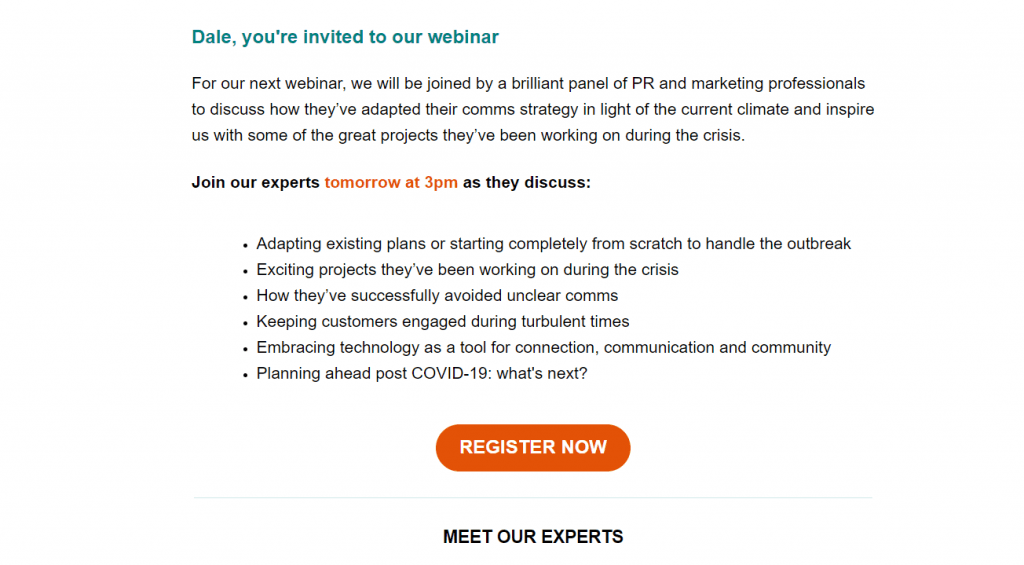
“For our next webinar, we will be joined by a brilliant panel of PR and marketing professionals to discuss how they’ve adapted their comms strategy in light of the current climate”
Do you see how they dive straight in with a benefit? - Insight into how PR and marketing professionals are adapting their strategies.
If this is an area of interest to me, it’s highly likely I’ll continue reading.
Successive Paragraphs
It’s now time to build on your good work. You might want to go into greater detail about the benefit you highlighted. Maybe provide evidence that it works?
In the case of the Cision webinar email, they decide to showcase the speakers’ credentials. Proof that they’re the real deal. That they’re worth listening to.
Again, keep it as short as possible. Pull out the hedge trimmer and prune away at unnecessary filler words
Ending
Should always be done with a CTA. Remember, the whole purpose of the email is to convince readers to take a specific action.
Make it clear exactly what you want them to do.
In the Cision email, there’s a large orange button embedded with the words:
REGISTER NOW
It’s clear, it stands out, I know what I’m supposed to do.
Personally, I think it’s better to stick with just the single CTA per mail. There’s no distraction or confusion as to what you want readers to do.
However, it’s definitely worth trialing. I know colleagues who’ve had success with embedded hyperlinks and multiple CTAs per page. So it really is up to you.
B2B Copywriting Done
Well, I think that about does it!
Unfortunately (or perhaps, fortunately) both space and time have forced me to leave out some of the things I wanted to cover in this guide - namely blog posts and whitepapers - but alas, here we are. Perhaps they’re areas I can cover in future posts.
What I have done is hone in on areas I consider key to B2B copywriting. Supporting them, where possible, with examples of companies I believe are doing a decent job of it.
If you are to take away something from this B2B copywriting guide, it’s always to keep your goals in mind. Then, do everything you can to understand your reader and connect them with your product or service.
This permeates throughout almost all forms of B2B copywriting.
Let me know what you think in the comments below.
Looking for something specific?





